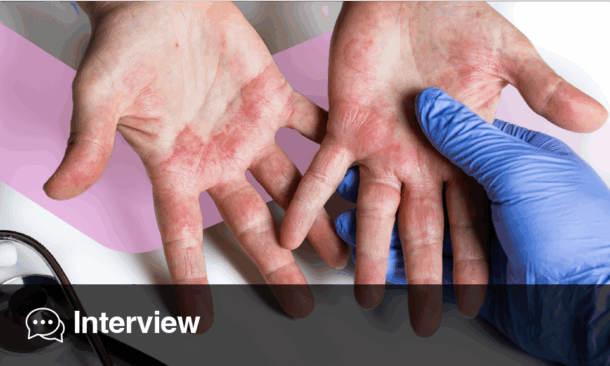Interview Summary
While for some individuals with atopic dermatitis (AD), the disease can be controlled with topical treatments, those with moderate-to-severe AD often require systemic therapy for long-term disease control. Systemic treatments for AD include conventional systemic agents, small molecule inhibitors, and biologics, each with its own risks and benefits. For example, conventional systemic agents carry significant risks with long-term use, and small molecule inhibitors require frequent dosing. Melinda Gooderham, SkiN Centre for Dermatology, Probity Medical Research, Queen’s University, Peterborough, Canada; Marjolein de Bruin-Weller, University Medical Center Utrecht, the Netherlands; and April Armstrong, University of California, Los Angeles, USA, are internationally renowned specialists in AD. Here, they discuss how the advent of biologic therapy for AD has changed clinical practice. One of the more recent biologic therapies to become available is tralokinumab. This is administered as a single injection every 2 or 4 weeks, is well-tolerated, and can be used over the long term without diminishing efficacy. Biologics such as tralokinumab are at the forefront of a change from flare-driven treatment to the management of AD on a stable, long-term basis, with associated improvements in health-related quality of life (HRQoL) for patients.INTRODUCTION
AD is a chronic, inflammatory skin disease characterised by pruritus and eczematous lesions, which can affect multiple body areas.1,2 For many individuals with AD, the disease can be controlled with topical treatments; however, most people with moderate-to-severe AD require phototherapy and/or systemic therapy to improve disease control and HRQoL.1,3 One of the newest systemic therapies for AD is tralokinumab, a high-affinity monoclonal antibody that specifically targets the cytokine IL-13, a key cytokine involved in the pathogenesis of AD. Tralokinumab is approved in several countries, including North America and the EU, for the treatment of moderate-to-severe AD in adults and adolescents.4,5
To discuss how the advent of biologics has disrupted the clinical management of AD and how tralokinumab fits into this paradigm, EMJ sat down with three specialists in AD: April Armstrong, Marjolein de Bruin-Weller, and Melinda Gooderham.
BIOLOGICS PROVIDE DURABLE TREATMENT RESPONSES THAT ARE WELL-TOLERATED OVER THE LONG TERM
In AD, patients can have varying degrees of baseline disease activity but also experience flares.1 Even patients with mild AD may need chronic topical therapy, such as corticosteroids and calcineurin inhibitors.6 “It is especially important that we keep the level of inflammation in check, so that patients don’t develop signs and symptoms of AD and don’t experience flares. To achieve this, they need to have long-term disease control with (systemic) therapeutic agents,” explained Armstrong. Gooderham places the currently approved systemic treatments for AD in three categories: conventional agents, small molecule JAK inhibitors, and biologics. Each of these groups has its own risks and benefits.6,7
Conventional systemic agents include corticosteroids, cyclosporine, and methotrexate, among others, all of which carry a significant risk, with a safety profile that includes long-term adverse events.3,8 Armstrong stressed that these risks are often not accepted by patients; however, Gooderham explained, on a global scale, they still play an important role because they are often more accessible in terms of cost compared to other treatment options.8,9
Small molecule JAK inhibitors are newer, fast-acting systemic therapies with a short half-life.10 However, Gooderham emphasised, this means that “if a patient misses a dose or goes off therapy, they are at risk of flaring”. JAK inhibitors can provide a high degree of symptomatic improvement,6 but they are also associated with an increased risk of infection11 and are accompanied by a black box warning for major adverse cardiovascular events, based on trial data in patients with rheumatoid arthritis.12
Biologics in AD, such as dupilumab, lebrikizumab, and tralokinumab, are considered to be very well tolerated and highly efficacious,7 and they have infrequent dosing intervals.4,5,13-16 These biologics produce a durable response,4,5,17 which, de Bruin-Weller explained, is quite unique. “With a lot of treatments, you see that over time patients lose their response. We didn’t see that in the trials, and I don’t see it in daily practice with biologics.”17-19 Armstrong added that “biologics have really changed the landscape of how AD is treated and is controlled long term”.
The Advent of Biologics in Atopic Dermatitis Has Changed Treatment Practices
“Clinical treatment for AD has really expanded over the past few years,” said Armstrong. “The advent of both biologics and oral medications has significantly changed the way we treat our patients, especially those with moderate-to-severe AD, such that our patients now have more efficacious, relatively safer choices compared to what they had before. This is an era of tremendous growth for AD, and our patients are really seeing a continued emergence of more medications that they could potentially benefit from in the future.”
De Bruin-Weller agreed, saying that “when the biologics came on the market, we had products that were well-tolerated and that you could really use long term. It completely changed my practice. Before [biologics], we had an inpatient ward with lots of beds for patients with AD who were admitted to the hospital for treatment with topical steroids, etc., and now that ward has completely disappeared.” The safety profile of biologics means that they can be administered at home, which is convenient for patients. “They get the instructions the first time they are at the office, then they do the injections at home and the side effect profile is relatively mild,” said de Bruin-Weller.
In the past, patients used topical therapies and increased the dose during a flare,20 but, Gooderham pointed out, treatment adherence could be an issue with this approach. Biologics require less frequent dosing, with an injection every 2 or 4 weeks.4,5,13-16
Biologics in Atopic Dermatitis Are Not Immunosuppressant
The main biologics currently available for AD are monoclonal antibodies that target either IL-4 and IL-13 together (dupilumab), or IL-13 specifically (tralokinumab, lebrikizumab). Both IL-4 and IL-13 drive Type 2 inflammation that is characteristic of AD and contributes to disease symptoms.21 This means that these biologics are immunomodulating drugs, altering a specific aspect of the immune system.22 “We always have to convince other doctors that [biologics for AD] are not immunosuppressive,” said de Bruin-Weller. “This is really unique for these biologicals because we use a lot of biologics in other diseases (such as TNF alpha inhibitors) with a more immunosuppressive effect.”23 Unlike JAK inhibitors, which target a different aspect of the inflammatory pathway,6 these biologics for AD are not associated with an increased risk of infection.11 In fact, they may actually decrease the risk of cutaneous infections.24
TRALOKINUMAB IN REAL-WORLD VERSUS CLINICAL TRIALS
The safety and efficacy of tralokinumab as monotherapy and in combination with topical corticosteroids and topical calcineurin inhibitors have been demonstrated in Phase II and III clinical trials.18,19,25 Up to 6 years of follow-up data from the parent trials and open-label extension trial ECZTEND,26 which included patients over 12 years of age with moderate-to-severe AD, showed that long-term use of tralokinumab was associated with robust, lasting efficacy with sustained improvements in AD signs, symptoms, and HRQoL. It was well-tolerated, with no new safety signals identified.27-29
“I think these days we especially talk about long-term control of AD with biologics,” said Armstrong. “We have over 3 years of clinical trial data assessing patients receiving tralokinumab and how they do over this long period of time. What was noted is that about seven out of 10 patients had no-to-mild disease, and, importantly, there was no-to-minimal disease fluctuation over 3 years of treatment.”30 In a post hoc analysis of ECZTEND, a stable EASI ≤7 response (at ≥80% of attended visits) was observed in 70.2% of tralokinumab-treated patients over Weeks 16–152.30 These data indicate that tralokinumab provides good control of baseline disease in AD and that patients have fewer flares.29 “I think that’s something our patients who are in a tralokinumab trial are experiencing, or expect to experience, and I think that is very important for their overall QoL.”
Real-world data for tralokinumab in AD is emerging from the ongoing TRACE study. A global, real-world, non-interventional investigation of tralokinumab in adults (≥18 years of age) with AD, TRACE aims to better understand the use of tralokinumab in clinical practice. Participants were enrolled from 11 countries across Europe, North America, and the Middle East.
A total of 631 patients were included in an interim analysis of TRACE, with a respective number of patients reaching each analysis time point. Data demonstrated that the mean Eczema Area and Severity Index (EASI) score improved from 20.1 at baseline to 6.4 at 3 months (among 482 patients), 5.4 at 6 months (among 212 patients), and 3.6 at 9 months (among 88 patients) of tralokinumab treatment. The proportion of patients with EASI ≤7 (no or mild disease) increased from 14% at baseline to 72% at 3 months (among 482 patients), 77% at 6 months (among 212 patients), and 80% at 9 months (among 88 patients). Among the patients with a baseline Investigator Global Assessment (IGA) score ≥2 (mild-to-severe disease; n=566), the proportion with at least a 2-point improvement in IGA was 46% at 3 months (among 566 patients), 58% at 6 months (among 279 patients), and 70% at 9 months (among 112 patients) of treatment. Dupilumab-naïve and dupilumab-experienced patients showed similar improvement across all efficacy endpoints, despite higher baseline disease severity in dupilumab-naïve patients.31,32
Armstrong, who presented some of the interim data from TRACE at European Academy of Dermatology and Venereology (EADV) 2024, commented that, with real-world data, “we see very good efficacy with tralokinumab, not only during the first 3 months but with continued improvement over time, as well as maintenance over a 9-month period of time.”32,33 Gooderham noted though how “we do see the classic profile of a biologic; there can be a slow onset for some patients while others respond a bit more quickly, but there is gradual improvement over time, even after the primary endpoint, which is why real-world evidence is important.”32
According to de Bruin-Weller, the real-world and clinical trial data are comparable and “match very well with our own registry data [where] we don’t see a lot of side effects. It was also very nice to see that the results from TRACE show good efficacy in both dupilumab-naïve and dupilumab-experienced patients.” Armstrong agreed, saying: “The efficacy of tralokinumab seems to stand, regardless of prior biologic therapy in the real world. I think that’s encouraging when considering tralokinumab for both biologic-naïve and biologic-experienced patients.”
In terms of patient-reported outcomes from TRACE, the proportion of patients with a Peak Pruritus Numerical Rating Scale ≤4 (worst itch intensity: none-to-moderate) increased from 23% at baseline (among 484 patients) to 52% at 3 months (among 261 patients), 68% at 6 months (among 125 patients), and 72% at 9 months (among 65 patients) of tralokinumab treatment. In connection with this, the proportion of patients with a Dermatology Life Quality Index score ≤5 (no-to-small effect on patient HRQoL) increased from 20% at baseline (among 446 patients) to 49% at 3 months (among 246 patients) and remained stable at 64% at 6 months (among 113 patients) and 9 months (among 69 patients) of tralokinumab treatment. The proportion of patients with a Sleep Numerical Rating Scale ≥3 (0–10, where 10 is the worst possible sleeplessness) at baseline who improved by ≥2 points increased from 65% at 3 months (among 142 patients) to 68% at 6 months (among 65 patients) and 82% at 9 months (of 39 patients) of tralokinumab treatment. Across all endpoints, similar improvements were observed in dupilumab-naïve and dupilumab-experienced patients.33
“We know (from the clinical trials) that tralokinumab is an efficacious treatment for patients with increasing benefits in skin clearance, as well as improvement in QoL and other patient-reported outcomes such as itch reduction, sleep improvement, and improvement of mental health,”18,19 said Gooderham. “Similarly, from the TRACE study, we see this gradual improvement throughout the first 9 months, with IGA scores of 0/1 [no-to-mild disease], improvement in QoL, a reduction in itch, and improvement in sleep.32,33 It’s great to see the real-world evidence confirming what we saw in the randomised controlled clinical trials. When a drug is approved based on Phase III pivotal clinical trial data, then to take it out in the real world and see it work the same way, it is very reassuring for both prescribers and patients.”
How Clinical Trial Data Differs from Real-World Data
Gooderham emphasised that clinical trial data and real-world data contribute value in different ways and discussed that while clinical trials are important for registrational purposes, “real-world evidence gives us a broader range of data to help inform us in managing our patients in clinic”.
One of the major differences between a clinical trial and real-world data is the included population. As clinical trials need to be powered to generate findings that are statistically significant, they have stringent enrolment criteria.34 However, de Bruin-Weller pointed out that “in daily practice, we have patients with comorbidities and co-medication who cannot enter a clinical trial”. Gooderham agreed, discussing how real-world evidence includes “patients with certain comorbidities, maybe a history of malignancy, or other systemic illnesses (that shouldn’t) preclude them from treatment of their AD”.
“When tralokinumab first came onto the market, a lot of patients who failed earlier biological treatment with dupilumab were put on tralokinumab,” said de Bruin-Weller. “And that is, of course, a more difficult-to-treat population [than that included in the clinical trials].” By expanding inclusion criteria, explained Armstrong, “real-world trials often reflect the broader range of clinical manifestations of AD (that we see in the) overall population”. Another issue de Bruin-Weller noted was how a patient in a more heavily controlled clinical trial environment may be compliant, but “compliance is sometimes an issue in daily practice”. She also stressed that follow-up can be longer in the real world compared with clinical trials and that the dose flexibility used in the real world can provide new information.
The benefit of clinical trials, rather than analyses of registry data, Armstrong explained, is that they are randomised. “If the trial is properly powered, you’re able to make a specific statement about a medication’s efficacy compared to another arm in the clinical trial and by a certain time point […] so we have confidence that the benefit that we see is attributable to the medication itself in a very rigorous and stringent fashion. However, the limitation of the clinical trial is that the patient population may be more selected.” She added: “Real-world and clinical trial data inform us differently about how a medication performs, so I think they both have tremendous value, and I think we as dermatologists want to pay attention to both of those sets of data.”
Discussing Trial Data with Patients
Armstrong stressed that she discussed trial data with her patients because she wants them to understand when to expect benefit from a treatment and what the magnitude of that benefit is likely to be. “I do believe in shared decision-making. I’m the one who needs to provide value by informing patients of what we know from the clinical trials, and our patients can inform us of their values, such as a preference for an oral or injectable therapy. I’m there to make sure that we make the best decision for the patient such that they can actually adhere to the therapy when they leave my office, because they also have to buy into that decision.”
De Bruin-Weller explained that, before there was much real-world evidence about tralokinumab available, she would use the trial data, particularly for the combination of tralokinumab with topical steroids, which shows good responses.18 She also used trial data to discuss safety, since long-term extension trials have shown that there are no new safety issues.26 However, now that there is more real-world evidence for tralokinumab in AD, de Bruin-Weller talks to patients mostly about this data, along with her own experience in clinical practice. “I also tell patients that the results that we see in our registry, in our daily practice, are comparable to the trials because sometimes you find that if you use a medicine in daily practice, [the outcomes] are different from the trials. For the biologics, it’s comparable.”
In general, Gooderham doesn’t use detailed data from clinical trials when discussing treatment options with patients. “As a clinical trialist for all of the new treatments in AD, I have the opportunity to tell stories of patients and give examples of how patients have responded to these new therapies, and I think that really speaks a bit more to my patients than using clinical trial data.” However, she admitted, “there are some patients who do their own research online and may have specific questions about treatments, in which cases, I do discuss some data with those patients”. Gooderham added that it may help “if you can discuss real-world data with patients, showing that someone like them, perhaps a patient with a remote history of malignancy or some other medical condition, received tralokinumab and did well over time”.
TRALOKINUMAB IN HEAD AND NECK ATOPIC DERMATITIS
Head and neck region involvement is reported in more than 70% of patients with moderate-to-severe AD2 and is associated with social embarrassment, stigmatisation, and a negative impact on patients’ HRQOL and mental health.35 Armstrong explained that head and neck AD can be very hard to treat and that not all therapies treat it consistently well.2,36 De Bruin-Weller agreed, saying how “head and neck AD is the most challenging area to treat […] AD on the hands is sometimes also difficult. These are the locations that the patients suffer from the most because they are the visible areas.”
A substantial proportion (80%) of participants in the TRACE study had head and neck involvement at baseline. Of these participants, only 67% still had head and neck involvement after 3 months of tralokinumab treatment, and 52% after 9 months.37 “It’s important to both prescribers and patients to see that benefit in head and neck dermatitis (with tralokinumab) from the real-world TRACE registry,” said Gooderham.
The Future of the Atopic Dermatitis Treatment Landscape
This is an era of considerable change in the AD treatment landscape. Armstrong stressed that there are now more treatment options available for patients with AD, with even more biologic therapies in the pipeline. For example, nemolizumab, an IL-31 receptor antagonist, was recently approved in the USA for prurigo nodularis;38 although, according to de Bruin-Weller, this drug is unlikely to be a “game changer” in AD. There are also antibodies in the pipeline that target OX40, a co-stimulatory T cell receptor, and the corresponding OX40 ligand.39 “I think it’s good to have biologics for a different pathway available, [in case a patient] fails [Type 2 inflammatory pathway]-targeting biologics,” said de Bruin-Weller.
Gooderham discussed how one of the unmet needs in AD at present is to develop safe, effective treatments that work for all patients. One of the reasons this is challenging is that AD “is a very heterogeneous condition with complex pathophysiology”. Expectations for how well AD-targeting drugs perform are increasing, said Armstrong. de Bruin-Weller also emphasised how, although current treatments improve AD considerably,18,19 “there is some residual disease activity and itch, and patients still need to use topical steroids so we need to improve efficacy.”
With well-tolerated biologics now available, it seems likely that systemic treatment will become more common in AD as awareness of this option increases among patients. “I still think that many patients don’t yet understand that this treatment option is available for them,” said Gooderham. “I think a lot of them are afraid of systemic treatment just from historical immunosuppressants that have been used.” Armstrong added that, in the near future, biologics may be considered for earlier stages of the AD disease course “such that we may even change the natural history of a patient’s disease.”
There are already some biologics approved for a broad age range of patients with AD,4,5,13,14 explained Gooderham. “So, instead of suffering for many years, patients will be able to start therapy at a young age. They’ll be able to control their disease, avoiding the cumulative life course impairment that happens with chronic illnesses such as inflammatory skin diseases. By treating patients early, with stable control over time, we will be able to reduce the anxiety and stigmatisation associated with flares, and improve the overall QoL for our patients.”40
Shifting from Flare-Driven Treatment to More Stable Disease Control
“We’re moving away from a flare treatment model where patients use topical therapies, and then they increase their use when they’re having a flare,” said Gooderham, who also noted that adherence can be an issue with this approach. “By treating with biologics where you have an injection every 2 or every 4 weeks, you’re able to manage the disease and prevent flares, reducing the amount of topical steroids or calcineurin inhibitors that are required.” Armstrong agreed that the conversation in AD therapy has already shifted towards stable disease control rather than flare-driven treatment. “Flare-driven treatment is really only appropriate for those patients who have just one flare per year, or maybe a seasonal flare,” explained de Bruin-Weller. “But most of our patients have more chronic disease, so we need to use maintenance treatments to extend the intervals [between flares]. I think we can reach that with biologics.”
Gradually, more patients with AD should become aware that well-tolerated, systemic treatments are an option for them. “They’ve spent their lives in a flare-driven treatment mode, using their topical therapies at greater frequency when they’re having a flare, trying to avoid [overusing] these therapies, so they end up suffering with flares that may not be managed appropriately,” explained Gooderham. “I think it will become more common to manage underlying disease with a treatment such as a biologic that can be used safely over the long term to manage those flares, so that patients can reduce the amount of topical steroids that are being used.”
CONCLUSION
The advent of biologic therapies, such as tralokinumab, that can be used over the long term without diminishing efficacy has disrupted the way that AD is treated in clinical practice. Gooderham summarised this by saying, “I look forward to that time when a patient’s disease is controlled and we’re just following them along their journey, managing their disease, and seeing the benefits in their QoL.”





